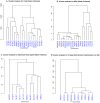Environmental Response and Genomic Regions Correlated with Rice Root Growth and Yield under Drought in the OryzaSNP Panel across Multiple Study Systems
- PMID: 25909711
- PMCID: PMC4409324
- DOI: 10.1371/journal.pone.0124127
Environmental Response and Genomic Regions Correlated with Rice Root Growth and Yield under Drought in the OryzaSNP Panel across Multiple Study Systems
Abstract
The rapid progress in rice genotyping must be matched by advances in phenotyping. A better understanding of genetic variation in rice for drought response, root traits, and practical methods for studying them are needed. In this study, the OryzaSNP set (20 diverse genotypes that have been genotyped for SNP markers) was phenotyped in a range of field and container studies to study the diversity of rice root growth and response to drought. Of the root traits measured across more than 20 root experiments, root dry weight showed the most stable genotypic performance across studies. The environment (E) component had the strongest effect on yield and root traits. We identified genomic regions correlated with root dry weight, percent deep roots, maximum root depth, and grain yield based on a correlation analysis with the phenotypes and aus, indica, or japonica introgression regions using the SNP data. Two genomic regions were identified as hot spots in which root traits and grain yield were co-located; on chromosome 1 (39.7-40.7 Mb) and on chromosome 8 (20.3-21.9 Mb). Across experiments, the soil type/ growth medium showed more correlations with plant growth than the container dimensions. Although the correlations among studies and genetic co-location of root traits from a range of study systems points to their potential utility to represent responses in field studies, the best correlations were observed when the two setups had some similar properties. Due to the co-location of the identified genomic regions (from introgression block analysis) with QTL for a number of previously reported root and drought traits, these regions are good candidates for detailed characterization to contribute to understanding rice improvement for response to drought. This study also highlights the utility of characterizing a small set of 20 genotypes for root growth, drought response, and related genomic regions.
Conflict of interest statement
Figures







References
-
- Pandey S, Bhandari H. Drought: economic costs and research implications In: Serraj R., Bennett J., Hardy B., editors. Drought Frontiers in Rice: Crop Improvement for Increased Rainfed Production. Singapore: World Scientific Publishing and Los Baños (Philippines): International Rice Research Institute; 2008. 10.3389/fphys.2012.00429 - DOI
-
- Serraj R, McNally KL, Slamet-Loedin I, Kohli A, Haefele SM, Atlin G, et al. Drought resistance improvement in rice: an integrated genetic and resource management strategy. Plant Prod Sci. 2011;14: 1–14.
-
- Serraj R, Kumar A, McNally KL, Slamet-Loedin I, Bruskiewich R, Mauleon R, et al. Improvement of drought resistance in rice. Adv Agron. 2009;103: 41–98.
-
- Chandra Babu R, Shashidhar HE, Lilley JM, Thanh ND, Ray JD, Sadasivam S, et al. Genetic variation in root penetration ability, osmotic adjustment and dehydration tolerance among rice lines adapted to rainfed lowland and upland ecosystems. Plant Breeding 2001;120: 233–238.
-
- Lafitte HR, Champoux MC, McLaren G, O’Toole JC. Rice root morphological traits are related to isozyme group and adaptation. Field Crop Res. 2001;71: 57–70.
Publication types
MeSH terms
LinkOut - more resources
Full Text Sources
Other Literature Sources
Miscellaneous

